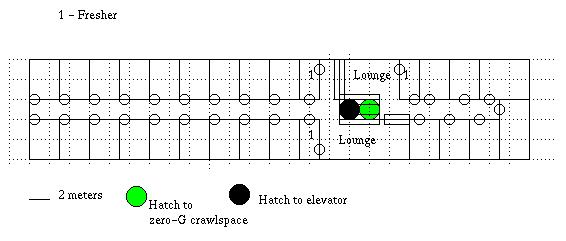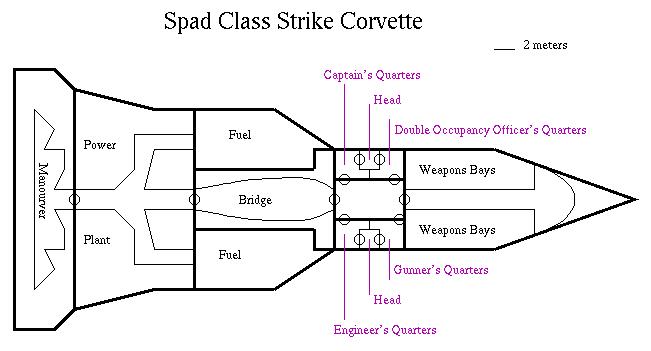CT Richtofen CT-L7515E3-09660090007-2 20000 tons batteries bearing 7 6 7 Crew=280 batteries 7 6 7 TL=14 Passengers=0 Low=0 Cargo=514 Fuel=1100 EP=1000 Agility=1 LS Spad LS-2106C11-40000046000-0 200 tons batteries bearing 11 Crew=7 batteries 11 TL=14 Passengers=0 Low=0 Cargo=0 Fuel=26 EP=26 Agility=6 T Camel Class C-A60112x-00000000000-0 1000 tons Crew=7 TL=14 Passengers=0 Low=0 Cargo=0 Fuel=834 EP=20 Agility=1The Richtofen class looks much like a child's toy jack as it floats in space. Six "arms" jut out from a common central point, and at the end of each delicate-looking arm is clamped a pair of Spads.
Along each arm are a series of nodes, flat decks which house portions of the jump and manouvre drives, powerplants, turrets, cargo, crew, and screen generators.
Most of these components are modular and can be attached in a variety of configurations. Standard tactical doctrine, however, calls for all essential functions to be dispersed as evenly as possible across the arms so as to minimize the damage from any individual hit. As a side-effect, should any arm be damaged beyond the in situ repair capability, its nodes can be clamped to any less damaged arms and the damaged arm jettisoned. A new arm can be fitted at naval base to return the ship to full functionalitly. It is this capability which has given the class the nick-name of "the Starfish."
The arms themselves are little more than long strands of conduit, through which pass data-cables and fibre-optic backups, an elevator shaft, a zero-G personnel shaft, and various other control systems. Each arm is roughly 1 kilometer long, and five meters in diameter.
The elevator system is worth a few extra notes. To begin with elevator is a misnomer, it is really a system of transport cars. Covering as it does about 1 km, it is desirable to have multiple units on each arm, three to be exact. So there are, in fact, three seperate elevator tubes and three zero-G personnel shafts. At intervals along the arm are cross-over points where the cars can move from one shaft to another, and a computerized system controls the traffic flow.
The elevators themselves are kept at a fractional G, usually around .2 or .3, and are aligned with direction of travel. This allows personnel to enter the elevator from zero-G with too much disorientation but keeps objects from flying up to the 'roof' when the elevator decellerates at a stop. Individual crew members tend to use the zero-G shafts from preference, leaving the elevators for cargo.
At the center of the ship is the bridge as well as docking space for the Camel class refueling barge.

This is a typical crew node, 50 meters by 10 meters, with 27 staterooms. The partitions dividing the two lounge areas are removable, and the configuration shown is common when it is desirable to seperate officers and crew, or Marines from Navy, or some other distinction. If the entirity of the node is of the same class and service, the walls are often removed to give a single large lounge. Even in this configuration the walls are actually large accordian doors which may be temporarily opened.
All fresher facilities are shared, although in the standard configuration the facilities are seperated as well.
The access to the arm is through two hatches toward the center of the node. The hatches are irises in the floor and the area above them is kept at zero-G. One hatch leads into the zero-G tube for those who do not wish to wait for the elevator. The other leads into the elevator.
The node is clamped to the arm along its long axis. Personnel nodes are usually affixed to the arm fairly close to the bridge; between the bridge and the outer engineering and gunnery nodes, so as to make travel from quarters to duty stations as easy as possible.
There are six crew nodes required for a full complement.
Richtofen Class CT Richtofen Carrier, 20000 tons (L) Dispersed (7) Jump-5 1200 tons Manouvre-1 400 tons Power Plant-5 2000 tons Jump Fuel-10000 tons PP Fuel-1000 tons Fuel Refiners-100 tons 1000 Energy Points Bridge-400 tons Computer-5fib (E) 10 tons Crew-Command:CO,Exec, Comp, Med, Commo, two Nav, four ratings Engineering: 3 Officers, 7 Petty Officers, 26 Crew Gunnery: Chief, 2 Officers, 5 Petty Officers, 26 Crew Flight: Flight Control Officer, 13 Maintainence Crew 7x12 Crew for Corvettes=84 1x7 Crew for Fuel Tender Ships Troops: 1 Officer, 59 Men Service Crew: 40 men Total Crew=280 Quarters: 10 Single, 150 double is 160 @4 tons, 640 tons Nuclear Dampers-6 12 tons, 60 Energy Meson Screens-6 24 tons, 240 Energy 200 Hardpoints Batteries 1-7 10 triple sandcaster turrets, 10 tons, 0 Energy Total 70 tons, 0 Energy Batteries 8-14 10 triple missile turrets, 10 tons, 0 Energy Total 70 tons, 0 Energy Batteries 15-20 10 triple laser turrets, 10 tons, 30 Energy Total 60 tons, 180 Energy Carries: 12 200 ton Strike Corvettes, 2400 tons Carries: 1 1000 ton Fueling Barge, 1100 tons Cargo: 514 tons Tonnage:18846 Energy Used: 480

Spad Class LS Strike Corvette, 200 ton (2) Needle (1) Manouvre-6 34 tons Power Plant-D 52 tons PP Fuel-26 tons Bridge-20 tons 26 Energy points Model 1 Computer 0 Energy Point, 1t Crew is: 7 Command Section: Pilot, Navigator, Medic Engineering Section: Two Engineers Gunnery Section: Two gunners Quarters: 1 single occupancy, 3 double - 4 @ 16 tons 50 ton Plasma Gun Bay, 50 tons, 10 Energy 1 Hardpoint Battery 1, triple laser turret, 1 tons, 3 Energy Tonnage Used: 200 t Energy Used: 12 Camel Class T Camel Fueling Barge, 1000 tons (A) Flattened Sphere (6) Manouvre-1 20 tons Power Plant-1 20 tons PP Fuel-20 tons Extra Fuel Space: 886 Fuel Scoops Fuel Refiners-20 tons 20 Energy Points Bridge-20 tons Computer-2 2 ton Crew:Pilot, Navigator, Medic, Engineer, Engineers Mate, two crew Total: 7 Quarters: 1 single, 3 double @ 4 tons, 12 tons Tonnage: 1000 Energy used: 0